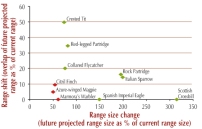
Species that are likely to experience a substantial proportional range loss and shift (with low overlap between present and projected future range) as a consequence of climate change are of particular concern. In Europe, modelling studies have identified a suite of endemic species that may be threatened by climate change in this way.

For ten landbirds endemic to Europe, the potential impact of climate change was assessed by modelling their recent (1980s) geographical distribution in terms of three climatic variables. This model was used to simulate their recent ranges, usually with good agreement between the observed and simulated ranges. The model was then used to map the area in which the climate is likely to be suitable for the species in the late twenty-first century under a future climate scenario (Gordon et al. 2000). The graph shows how well the projected and current modelled ranges match up in overlap (y axis) and extent (x axis). For six species, the area where climate is suitable will decrease (x axis values less than 100). Even where this does not occur, the climate space associated with the species may shift so much that there is little overlap between future and current modelled ranges. For eight species, less than 20% overlap is predicted and for three species there is no predicted overlap at all. Species with low values on either axis might be at risk, but those with low values on both axes—those marked in red on the graph—may be of particular conservation concern (Huntley et al. 2007, 2008).
Related Species
References
Gordon, C., Cooper, C., Senior, C. A., Banks, H., Gregory, J. M. Johns, T. C., Mitchell, J. F. B. and Wood, R. A. (2000) The simulation of SST, sea ice extents and ocean heat transports in a version of the Hadley Centre coupled model without flux adjustments. Clim. Dynam.16: 147–168.
Huntley, B., Green, R., Collingham Y. and Willis, S. G. (2007) A climatic atlas of European breeding birds. Barcelona, Spain: Lynx Edicions.
Huntley, B., Collingham, Y. C., Willis, S. G., and Green, R. E. (2008) Potential impacts of climatic change on European breeding birds. PLoS ONE 3(1): e1439. doi:10.1371/journal.pone.0001439.
Compiled: 2004 Last updated: 2008
Recommended Citation:
BirdLife International (2008)
In Europe, species with ranges that both contract and shift are likely to be most at risk.
Downloaded from https://datazone.birdlife.org/sowb/casestudy/in-europe-species-with-ranges-that-both-contract-and-shift-are-likely-to-be-most-at-risk on 22/12/2024